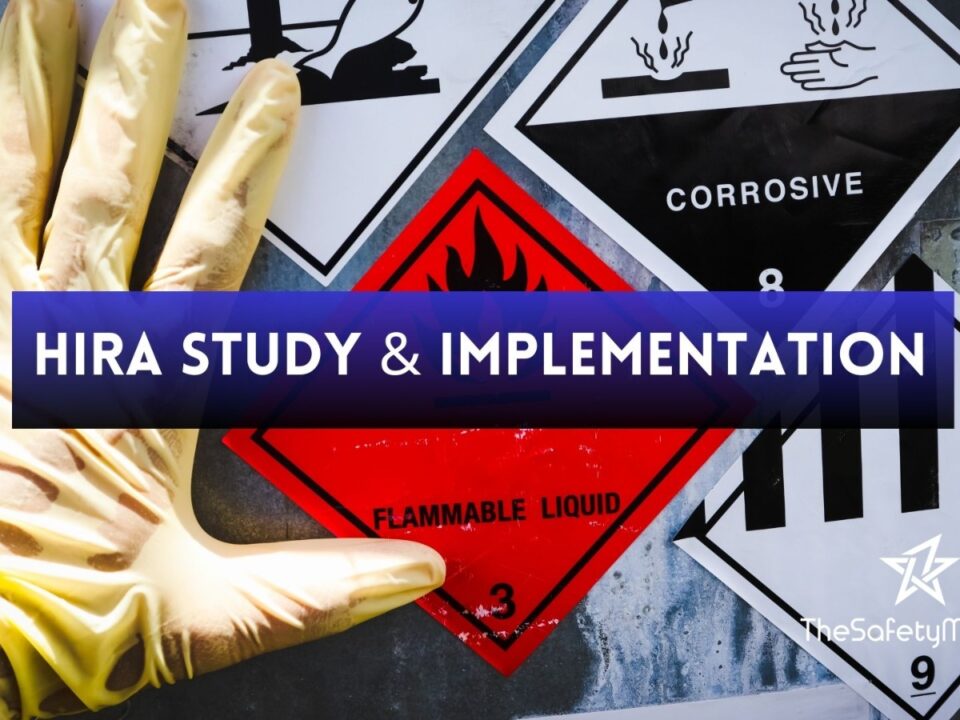Scaffolding Safety Training: A Proactive Approach Towards Employee Protection in Indian Industries

Fire Safety Audit: Ensuring Compliance and Preventing Catastrophes in Indian Industries
October 26, 2023
The Importance of Construction Safety Audits: Ensuring a Secure Working Environment for Employees
October 26, 2023In this article, we delve into a crucial aspect of workplace safety that often goes unnoticed in Indian industries – scaffolding safety training. With the rapid growth of construction and industrial sectors, ensuring employee protection has never been more vital. We aim to shed light on the problem at hand, discussing its implications and the risks associated. But fear not, dear reader, as we present a proactive approach that will empower organizations to prioritize employee safety through comprehensive scaffolding safety training programs. Get ready to embrace the promise of safeguarding your workforce and building a secure future. Let’s delve in.
Introduction
In the fast-paced world of Indian industries, ensuring the safety and well-being of employees is paramount. One area that requires particular attention is scaffolding, a vital component in numerous construction and maintenance projects. The importance of proper scaffolding cannot be overstated, as it provides a stable platform for workers to perform their duties at elevated heights. However, without adequate training and awareness of scaffolding safety protocols, workers may be exposed to significant risks and potential accidents. This article aims to shed light on the critical topic of scaffolding safety training in Indian industries. We will delve into the risks associated with improper practices, explore the regulations in place, highlight key elements of effective training programs, and discuss how employers can create a culture of safety. By adopting a proactive approach towards scaffold safety, we can ensure that employees are protected while they undertake their essential tasks
Importance of Scaffolding Safety Training in Indian Industries
In the bustling landscape of Indian industries, where progress and productivity are highly valued, ensuring the safety and well-being of employees should never be compromised. The importance of scaffolding safety training cannot be overstated in this context. Scaffolding, a crucial component in construction and maintenance work, presents inherent risks that can lead to serious accidents if not managed properly. With the rapid growth in infrastructure development across India, the need for skilled workers who can confidently and safely handle scaffolding installations has become paramount. Scaffolding safety training plays a vital role in equipping workers with the knowledge and skills necessary to identify potential hazards, adopt appropriate safety measures, and effectively mitigate risks.
Moreover, fostering a culture of safety within Indian industries is not only legally mandated but also morally imperative. By investing in comprehensive scaffolding safety training programs, employers demonstrate their commitment to prioritizing employee welfare. This proactive approach ensures that workers return home unharmed each day while instilling confidence among employees that their employers genuinely care for their well-being.
By placing emphasis on scaffolding safety training, Indian industries can cultivate a work environment where employees feel valued, protected, and empowered to carry out their tasks with utmost diligence. It is through this holistic approach that we pave the way for safer workplaces that contribute to both individual success and national progress
Understanding the Risks Associated with Improper Scaffolding Practices
Section: Understanding the Risks Associated with Improper Scaffolding Practices in the realm of scaffolding, where elevation and construction converge, a keen understanding of the risks associated with improper practices is of paramount importance. As workers ascend to great heights, their safety hangs precariously in the balance. One misstep, one overlooked precaution can lead to unforeseen consequences that ripple through the delicate fabric of a project.
Picture this: a bustling construction site where scaffolding stands tall like skeletal guardians, supporting workers as they navigate their elevated tasks. Yet beneath this seemingly sturdy structure lies an undercurrent of danger. A momentary lapse in attention or a failure to follow established safety protocols can have devastating consequences – not just for individuals but for entire teams and their families who rely on them.
To grasp the gravity of these risks is to acknowledge that every bolt secured and every inspection conducted acts as a guardian angel shielding workers from harm’s way. It serves as an unwavering reminder that diligent adherence to proper scaffolding practices is not just an obligation but a moral imperative – providing reassurance that each worker’s well-being is being actively safeguarded within an industry known for its resilience and dedication to progress.
Remember: by unravelling these risks and imbuing industry professionals with knowledge, we forge a path towards safer worksites – ones defined by confidence and collective responsibility. Together, we can foster an environment where accidents are minimized, injuries are prevented, and workers return home at day’s end knowing they have triumphed over adversity in the name of progress.
Overview of Scaffold Safety Regulations in India
Overview of Scaffold Safety Regulations in India: In the realm of scaffold safety, Indian industries have embraced a stringent regulatory framework to safeguard the lives of their workers. The government has put forth comprehensive regulations that address every aspect of scaffolding operations, from design and erection to dismantling and inspection. These regulations aim to ensure that scaffolding structures are robust, stable, and capable of bearing the weight they are intended for.
Under these regulations, employers are mandated to provide appropriate training and supervision for workers involved in scaffold operations. Additionally, detailed guidelines dictate minimum safety requirements for scaffolds, including factors such as load capacity, stability measures, guardrails, access points, and protective equipment. Such meticulous attention to detail ensures that workers can perform their tasks with confidence while minimizing the risk of accidents or injuries.
By adhering to these scaffold safety regulations, Indian industries demonstrate their commitment towards creating a secure working environment. This proactive approach not only protects employees from harm but also fosters increased productivity as workers feel secure in their workplace. It is heartening to witness the concerted efforts made by Indian industries in upholding these regulations and prioritizing the well-being of their workforce amidst an era driven by progress and technological advancements.
Key Elements of an Effective Scaffolding Safety Training Program
To ensure a comprehensive and impactful scaffolding safety training program, several key elements must be incorporated. Firstly, theoretical knowledge should cover the fundamental principles of scaffold design, erection, and dismantling techniques. Workers need to understand the various types of scaffolding systems, their components, load capacities, and proper utilization. Practical training is equally vital. Hands-on exercises allow workers to apply their theoretical knowledge in a controlled environment under expert supervision. This enables them to gain confidence in erecting and dismantling scaffolds correctly while using appropriate personal protective equipment (PPE) such as harnesses and helmets.
Furthermore, interactive sessions that encourage engagement and discussion among participants foster a stronger understanding of potential hazards and safe practices. Such sessions should explore real-life case studies emphasizing the consequences of ignoring safety protocols or taking shortcuts when working at heights.
By incorporating these key elements into an effective scaffolding safety training program, employers can empower their workers with the necessary skills and knowledge to ensure a safe work environment on construction sites across India. This proactive approach not only protects employees but also contributes to increased productivity and overall job satisfaction within the industry.
Choosing the Right Training Provider: Factors to Consider
Choosing the Right Training Provider: Factors to Consider Selecting a reputable training provider is crucial when it comes to ensuring the effectiveness of scaffolding safety training. Here are some essential factors to consider in this decision-making process:
1. Expertise and Accreditation:
Look for a training provider with extensive experience and expertise in scaffolding safety. Ensure they are accredited by recognized organizations or regulatory bodies, such as the Occupational Safety and Health Administration (OSHA) or the National Safety Council (NSC). This ensures that their training programs meet industry standards and regulations.
2. Comprehensive Curriculum:
Opt for a training provider that offers a comprehensive curriculum covering all aspects of scaffolding safety, including risk assessment, equipment inspection, proper assembly, dismantling procedures, fall protection techniques, and emergency response protocols. A well-rounded program will equip workers with the necessary knowledge to mitigate potential hazards effectively.
3. Interactive Learning Methods:
Consider training providers that employ interactive learning methods to engage participants actively during the sessions. Utilizing multimedia resources, practical demonstrations, case studies, and hands-on exercises fosters an immersive learning experience that enhances comprehension and retention of critical safety practices.
By carefully considering these factors when selecting a scaffolding safety training provider, employers can ensure that their workers receive top-notch education that empowers them to create a safe work environment while enhancing their skills and confidence on-site. Remember: investing in employee protection today leads to a brighter future for both individuals and industries as a whole.
Importance of Practical Training and Hands-on Experience
The Importance of Practical Training and Hands-on Experience in the realm of scaffolding safety, theoretical knowledge alone is not sufficient to ensure a safe working environment. Practical training and hands-on experience play a vital role in equipping workers with the necessary skills to execute their tasks safely and efficiently. The significance of practical training lies in its ability to bridge the gap between theory and real-life scenarios, enabling workers to develop critical thinking skills and problem-solving abilities.
By immersing themselves in hands-on experiences, workers gain a deep understanding of the challenges and complexities involved in working with scaffolding systems. They learn how to identify potential hazards, make informed decisions, and take necessary precautions to prevent accidents. Practical training sessions allow them to familiarize themselves with various scaffolding components, practice assembling and dismantling structures, and simulate different work conditions.
Moreover, hands-on experience instils confidence among workers by providing them with opportunities to apply their theoretical knowledge in a controlled environment. This boosts their morale and encourages them to remain proactive in adhering to safety protocols at all times. Ultimately, practical training enhances overall competency levels within the workforce while instilling a sense of ownership for employee well-being.
Emphasizing practical training not only contributes to safer work environments but also cultivates an optimistic culture that values continuous learning and improvement. It ensures that workers are well-prepared for any challenges they may encounter on construction sites or industrial settings – empowering them with the skills needed for success while fostering a positive mind-set towards safety practices
Incorporating Scaffolding Safety into the Overall Safety Culture
Incorporating Scaffolding Safety into the Overall Safety Culture strong and resilient safety culture is crucial in fostering a safe and secure work environment. When it comes to scaffolding operations, integrating safety practices into the overall organizational culture is paramount. It ensures a proactive approach towards employee protection and enhances the company’s commitment to their well-being.
To truly embed scaffolding safety into the fabric of an organization, it requires more than just conducting training programs. It necessitates a comprehensive strategy that involves active engagement from all levels of the workforce – from top management to supervisors and workers on-site. By instilling a sense of shared responsibility for safety, each individual becomes an advocate for maintaining high standards in scaffolding operations.
One powerful way to foster an inclusive safety culture is by encouraging open communication channels throughout every aspect of the organization. Workers should feel comfortable reporting any potential hazards or unsafe practices related to scaffolding, without fear of retribution. This creates an atmosphere where continuous improvement can thrive as concerns are addressed promptly, leading to safer working conditions for all.
By embracing scaffolding safety as an integral part of the overall safety culture, organizations not only prioritize employee well-being but also demonstrate their commitment towards excellence in every aspect of their operations. This proactive approach fosters trust and loyalty among employees while reinforcing that their lives matter beyond just being mere cogs in a machine. Ultimately, it paves the way for a brighter future where workplace accidents become relics of the past, replaced with a shared vision of optimal employee protection in Indian industries.
Roles and Responsibilities of Employers, Supervisors, and Workers in Scaffolding Safety
In the realm of scaffolding safety, a harmonious interplay between employers, supervisors, and workers is crucial to ensure a proactive approach towards employee protection. Employers must take the lead in establishing a robust safety culture, providing adequate resources for training programs, and implementing stringent safety policies. By fostering an environment that prioritizes worker well-being, employers create a foundation for a safe and productive workplace. Supervisors play a pivotal role in scaffolding safety by effectively communicating the importance of adherence to safety protocols to their subordinates. They should not only possess comprehensive knowledge of scaffolding operations but also demonstrate strong leadership skills to guide workers in safe practices. By actively monitoring work processes and promptly addressing any deviations from established safety procedures, supervisors instil confidence among workers and foster an atmosphere of collective responsibility.
Workers, as the ones directly engaged in scaffolding activities, bear immense responsibility for their own well-being as well as that of their colleagues. They should undergo thorough training on proper handling techniques, hazard identification, and emergency response procedures. Embracing personal accountability for following safety guidelines while maintaining open communication with supervisors creates an empowered workforce that actively contributes to accident prevention.
By delineating clear roles and responsibilities among employers, supervisors, and workers in scaffolding safety measures, Indian industries can establish a collaborative framework that ensures maximum employee protection while fostering increased productivity. Such unity paves the way for improved work environments where every individual feels valued and motivated to contribute meaningfully towards organizational success – ultimately creating a positive ripple effect throughout the industry at large.
Common Mistakes to Avoid in Scaffolding Operations
Common Mistakes to Avoid in Scaffolding Operations: One of the most common mistakes in scaffolding operations is inadequate base preparation. A strong and stable foundation is essential to ensure the stability of the scaffold structure. Neglecting proper levelling, compacting the soil, or placing an unsupported scaffold on an uneven surface can lead to accidents and collapse. Remember, a solid foundation supports both safety and success.
Another crucial mistake to be aware of is improper planking or decking. Using damaged or weak planks can compromise the structural integrity of the scaffolding system, putting workers at risk. Regular inspections for cracks, warping, or decay in wooden planks are vital for identifying potential hazards and ensuring safe working conditions. By prioritizing high-quality materials and ongoing maintenance, you lay a sturdy path towards a secure workplace.
Additionally, overlooking proper bracing and tying can have disastrous consequences. Failing to adequately brace scaffolds during assembly or neglecting to tie them securely to the building can result in swaying or instability. This puts workers’ lives on a precarious edge. By paying careful attention to these crucial details and actively reinforcing connections, you firmly establish a culture of safety where employees feel supported – both figuratively and literally.
Remember: Understanding these common mistakes empowers us to avoid them altogether – building safer workplaces brick by brick
Regular Inspection and Maintenance of Scaffolding Systems
Regular Inspection and Maintenance of Scaffolding Systems: Maintaining the integrity of scaffolding systems is crucial for ensuring a safe working environment in Indian industries. Regular inspection and maintenance procedures play a pivotal role in identifying potential hazards and addressing them promptly. By adhering to these practices, employers can minimize the risk of accidents, thereby safeguarding their employees’ well-being.
During routine inspections, trained professionals thoroughly examine every component of the scaffold structure, checking for signs of wear and tear, corrosion, or any other damage that may compromise its stability. This meticulous approach helps identify weak points before they escalate into more significant issues. Additionally, inspections provide an opportunity to assess the overall effectiveness of safety measures implemented within the scaffolding system.
Maintenance activities involve proactive measures such as tightening loose connections, replacing damaged parts, and applying protective coatings to prevent corrosion. Timely maintenance not only extends the lifespan of scaffolding systems but also guarantees optimal performance. By prioritizing regular inspection and maintenance routines, employers demonstrate their commitment to employee safety while fostering a culture where workers can trust in the reliability of their work environment
Evaluating the Effectiveness of Scaffolding Safety Training
Evaluating the Effectiveness of Scaffolding Safety Training: The assessment of scaffolding safety training programs is crucial to ensure their effectiveness in protecting employees and preventing accidents. One key factor in evaluating the effectiveness of such training is the measurement of knowledge retention and comprehension. Through comprehensive assessments, employers can gauge whether employees have grasped the essential concepts and regulations related to scaffolding safety.
Additionally, evaluating the practical application of learned skills is vital. Conducting on-site observations and simulations can provide valuable insights into how well workers are able to implement safe scaffolding practices in real-life scenarios. This allows employers to identify any gaps or areas that require improvement, ensuring that employees are adequately prepared to handle potential hazards.
Furthermore, gathering feedback from participants is a valuable aspect of assessing training effectiveness. By soliciting input from trainees, employers can gain valuable insights into their experience and identify areas where the training could be enhanced or modified for better results. This collaborative approach fosters a sense of ownership among employees and encourages them to actively contribute towards creating a safer work environment.
By regularly assessing the effectiveness of scaffolding safety training programs, employers display their commitment towards continuous improvement and employee well-being. Ultimately, an optimally effective training program will not only instil a sense of confidence within workers but also contribute to increased productivity, decreased incidents, and an overall positive work culture dedicated to employee protection.
Conclusion
In conclusion, prioritizing scaffolding safety training is crucial in Indian industries to safeguard the well-being of employees and elevate overall workplace safety. By understanding the risks associated with improper scaffolding practices and implementing comprehensive training programs, employers can foster a culture of proactive protection. With regular inspections, proper maintenance, and adherence to regulations, the workforce can work confidently and efficiently in a secure environment. Remember, investing in employee safety today ensures a brighter tomorrow for both workers and businesses alike.



